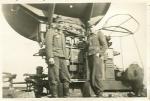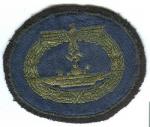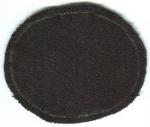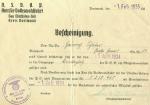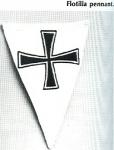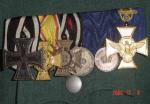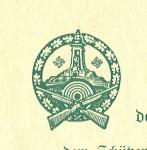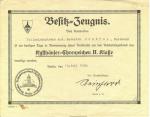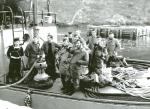
John Burchell
Valued Member-
Posts
285 -
Joined
-
Last visited
Content Type
Profiles
Forums
Blogs
Gallery
Events
Store
Everything posted by John Burchell
-
Kriegsmarine Cloth U-Boat Badge
John Burchell replied to John Burchell's topic in Wehrmacht Medals, Decorations & Awards
Thank you very much, Gordon. I fully understand and respect your comments. This leaves me sufficient room to at least not want to pitch this one in the fake drawer. At the very least, it makes an interesting conversation piece and addition to my U-Boat grouping. Once again, thanks for your feedback. -
Kriegsmarine Cloth U-Boat Badge
John Burchell posted a topic in Wehrmacht Medals, Decorations & Awards
This one has been in my collection for many years and I have recently been led to believe that it could be a reproduction produced in the 1970s. I see in Gordon Williamson's excellent new book on U-Boat collectibles that cloth versions were authorized and manufactured, known original examples being machine-embroidered in fine golden-yellow yarn on a blue oval wool patch; hand-embroidered in bullion wire, and a machine-woven "BeVo" pattern in gold wire thread on a dark blue artificial silk (rayon) base. This example would appear to approximate the third type mentioned, machine-applied onto a blue oval woolen backing. I would greatly appreciate opinions on this example shown as to probable period authenticity or not. Thanks in advance, John -
Masonic or Fraternal Medal
John Burchell replied to John Burchell's topic in Masonic Medals & Jewels
Thank you for the feedback. That will help me to focus in researching this medal. If I am successful, I will share further details here for others to see. Quick update: A search under Orange Order shows that there are "Purple" degrees in that order, and the ribbon on this medal is of that colour - if that is of significance in identifying the affiliation of this particular medal. As well, the five-pointed star depicted on the medal obverse is confirmed as a symbol used in the Orange Order (and Freemasonry) as an esoteric representation of the five points of fellowship. I noticed that there is also a "Prince of Mercy" degree, and was wondering if that somehow fits with the "P.C.M." lettering inscribed on the top bar on the medal ribbon? The recipient was obviously a "Worshipful Brother" in the order. -
Here is a medal which I acquired in a lovely fold-over, black leatherette, velour-lined case. The bars on the obverse of the ribbon have the lettering "P.C.M.", "Middlesex" and "East". Around the perimeter is a lovely wreath of what I assume to be Canadian maple leaves. The reverse is engraved, "Presented to / Wor. Bro. W.V. Matthews / C.M. 1935-36". At the bottom on the reverse is stamped "Dom. Reg. Co." (for Dominion Regalia Company - a Canadian company based in Toronto) and "Sterling". From the star (and two gavels) appearing on the obverse, I thought that this might be for the "Order of the Eastern Star", but research shows the star in that case to be inverted with various symbols in each of the five arms, so I am unsure about the affiliation of this particular medal. Can anyone please enlighten me as to which fraternal or other organization this medal belongs, and for what it was presented? An indication of the current value would also be appreciated. Thanks, John
-
Here is the document confirming my man's appointment as "Kameradschaftsfuhrer" in the DRKB "Kyffhauser" dated 9.Februar 1938. (Note the Kyffhauserbund Type 1 logo, ie. no swastika). Can anyone please tell me what kind of armband he might have worn, given this ranking in the organization? I have seen various ones out there, but am unsure which one I should try and acquire that is appropriate to his position at that time. Thanks, John
-
Burgerhaus (Robert) - If I am not mistaken, the pin you posted in #3 above is an association membership pin of the: Verband der Kriegsbesch?digten und Kriegerhinterbliebenen im Deutsche Reichskriegerbund Kyffh?user (Roughtly translated: League/Association of War Wounded and Missing-in-Action Members of the DRKB Kyffhauser)
-
OK, many thanks for your excellent feedback, Gordon and John. Post-war and Bundesmarine it is! I will see if I can find out anything about the ships mentioned and report back if something comes-up. Cheers! John Update: Here is some feedback from a Canadian Navy contact of mine on assignment with NATO in the U.S., who consulted with his German Navy colleagues also located there: Quote I showed the pictures to some of the German naval officers here in Norfolk. One of them thought that this is the distinguishing pennant of a commander of a mine countermeasures squadron that was based in the Baltic very near the East German border in the 70s or 80s. He served there as a junior officer at that time, and he seemed relatively certain of this. He said that the squadron commander would almost certainly have also been a commanding officer of a ship, as well as the commander of the squadron. He thinks that the names on the pennant were those of the officers in his ship and probably not of the commanders of the other ships in the squadron--they would have probably been more senior in rank. Leutnant zur See (Lt z S) is the most junior officer rank in the German Navy, and it looks like three of the five signatures on the pennant had this rank. The other two signatures were for Oberleutnant zur See (OLt z S) who just might have been senior enough to command a small ship but were just as likely to be the next senior officers to the ship's captain/squadron commander. I very much agree with your assessment that this signed pennant was a presentation memento--possibly to the captain/squadron commander as he was posted off the ship. Unquote
-
Ray Chowdery states on pages 108 & 109 of his book (referenced above) that: "In keeping with the stronger centralizing tendencies which asserted themselves after the First World War in Germany, the several State leagues of ex-service men were in 1921 united in a Reich League (Deutscher Reichskriegerbund Kyffhauser), under a central directorship which was conservative though not political....It fought neither for nor against rising National Socialism, but bowed promptly to that upstart force, like most other German conservatives. On May 7, 1933, it submitted its fate to Adolf Hitler who decreed that: 'The Kyffhauser League is the great soldiers' league for all Germany.'" Apparently other ex-servicemens' organizations continued for a few years, with the exception of the"Stahlhelm", "...the demise of [which] was declared on November 7, 1935, the founding date of the 'Soldatenbund' (a new 'Soldiers' League' formed by the commander of the Army on orders of the Reichswehr Minister with the consent of the Fuhrer), as well as the day when the new swastika war flag was for the first time hoisted by all Army and Navy units....This new league was to be composed of former members of the Reichswehr and the new Army....those who had been honorably discharged...after January 1, 1921....altogether voluntary. At the same time the Kyffhauser Bund and a few other surviving ex-servicemen's organizations were to receive those who had served before 1921....The Steel Helmet men were told to join singly either the Nazi party and its organizations, if they had political interests, or the Kyffhauser League if there interests were merely soldierly or sentimental." "The Soldatenbund saw a short period of prosperity"....however "A Fuhrer decree on March 4, 1938, taking cognizance of certain attempts on the part of the Army and other officers to preserve the ex-service men's organizations as reserves of their own, made the NS Reichskriegerbund, NSKB, as it was henceforth to be called, the one and only ex-soldiers' organization in the Reich. It was to include all former members of the old Army and Navy and of the new Wehrmacht, with only two exceptions - the NS League of War Victims (NS Kriegsopferverband, NSKOV), and the Reich Loyalty League of Former Professional Soldiers (Reichstreubund ehemaliger Berufssoldaten)."" A bit long-winded quoting this text, but hopefully helpful in answering Nick's question.
-
Quote: Sept. 1934-1936: Weeding out of SA reserve begins, @ 350,000-1,000,000 expelled/resign. You will see many very nice documents issued from 1935-1936 to expelled SA Reserve members (or those who resigned) saying "Service Honour diploma" etc..Unquote Thank you Ulsterman!...and a very interesting 2 pennies they are! Amongst "my man's" documents are the following, which I believe underscore your chronologically-historical input: A. The first dated 1.Feb.1935 confirming his membership candidacy application (1.April 1934) and acceptance into the NSDAP (1.Juli 1934) as member Number 1,238,465; and B. The second dated 31.Dezember 1935 confirming his voluntary and honourable withdrawal from SA membership following his term of service and having fulfilled his duties in the SAR II from 10. Juli 1934 to 31.12.1935, in accordance with the decree by the Chief of Staff of the Supreme Command of the SA: F Nr. 63 140 of 22.November 1935 concerning the "Consolidation of SAL and SAR Units". As shown above, he received his 2nd class service award from the DRKB on 15. Juli 1936. An interesting feature of most of his documents which I possess is that they are signed by ex-Colonel, later General of Infantry and SS-Gruppenfuhrer Wilhelm Reinhardt who was an early member of the Nazi Party and the SS, and was appointed new leader (Reichskriegfuhrer) of the DRKB on the Emperor's birthday, January 27, 1934. Cheers, John
-
While it began over my question of which award fits the document posted, I am enjoying and learning from this interesting discussion and appreciate the input from members. Don Scowen and I had separately touched upon the matter of DRKB insignia appearing on a number of shooting award documents spanning a period of years, which appear to document the evolution of that insignia, with and without the swastika - and this continues here. The most detailed information regarding the Kyffhauser League (Kyffhauserbund) c. 1872; its' successor the DRKB (Deutscher Reichskriegerbund - Kyffhauser) c. 1921; and the NS-RKB or NSKB (National Socilalist Reichskriegerbund) c. 1938 (when, by Fuhrer decree it became "the only ex-soldiers' organization in the Reich"), that I can find is contained in a book by Ray Chowdery entitled, "Nazi Para-Military Organizations and their Badges" published in 1985. The origin and evolution of this veteran's society or league is covered therein. However, the evolution of the logo on badges and documents of the organization is not clearly shown. The "Kyffhauser-Ehrenzeichen II. Klasse" award document above indicates that it is presented to a comrade/member in recognition of his services to the DRKB, therefore clearly not a military service medal. I assume the format to be a medal or badge of sorts (Ehrenzeichen = decoration), as opposed to the pin/stickpin ("Ehrennadel") format used for membership and shooting awards. Note that this service award document presented in 1936 bears the swastika - positioned below the monument - in the organization logo and seal. The use of a swastika in the DRKB logo appears somewhat inconsistent around the mid-1930s (see membership stickpins and logos appearing on shooting award documents below from 1935, 1936 & 1937 respectively). It presents the question of whether the recognized Type I (without swastika) and Type 2 (with swastika) should be expanded to recognize another type appearing between the years on documents (ie. swastikas on either side of the monument). In any case, I remain hopeful that a positive confirmation of the award appropriate to the document above can be made, and look forward to additional discussion. Regards, John
-
Thanks for your feedback, Jef and Kev. If that is, indeed, the award that goes with the document, then I'll start looking for one of those 2nd class medals. Not sure, Robert, what the significance of the stickpin may be, but it surely has a "Kyffhauser" connection since it does depict the monument. I assume that the monument still stands and can be visited. Curious to know if any members have been there? Regards, John
-
Here is one of the award documents (this one dated 1936) which I have that were awarded to the same man over a period of years from WW1 & WW2, as a member of the DRKB. I would like to know what this award looks like, as I am trying to complete the missing awards that match the appropriate documents. Can anyone help-out by posting a picture of this particular award, please? Thanks, John
-
Kriegsmarine New U-Boat Book.
John Burchell replied to Gordon Williamson's topic in Wehrmacht Medals, Decorations & Awards
I received mine, #240, last week. It took a while to make it's way through Canadian Customs, but was well worth the wait! This is a tremendously informative and extremely-well illustrated book and a fine addition to any KM/U-Boot reference library. My congratulations to the author and best regards, John Burchell. -
Kriegsmarine U-190
John Burchell replied to Steve campbell's topic in Wehrmacht Medals, Decorations & Awards
-
Kriegsmarine U-190
John Burchell replied to Steve campbell's topic in Wehrmacht Medals, Decorations & Awards
-
Kriegsmarine U-190
John Burchell replied to Steve campbell's topic in Wehrmacht Medals, Decorations & Awards
-
Kriegsmarine U-190
John Burchell replied to Steve campbell's topic in Wehrmacht Medals, Decorations & Awards
-
Kriegsmarine U-190
John Burchell replied to Steve campbell's topic in Wehrmacht Medals, Decorations & Awards
-
Kriegsmarine U-190
John Burchell replied to Steve campbell's topic in Wehrmacht Medals, Decorations & Awards
-
Kriegsmarine U-190
John Burchell replied to Steve campbell's topic in Wehrmacht Medals, Decorations & Awards
Thanks, Martin and Laurence. Yes, I still have the photos and will post a few here, as requested. 1. The U-190 following arrival and moored in Bay Bulls Harbour on May 14, 1945. 2. The Q 095, a RCN Fairmile B-Type Motor Launch, on which the Leading Seaman and UDT member whom I mentioned above was aboard, which met and guided the submarine to her moorings in Bay Bulls harbour. 3. Crew members of the U-190 after arrival in Bay Bulls, looking rather pleased that the war is over for them. 4. The nine ratings who had stayed on board the U-190 to assist running and bringing her into port, shown here assembled and ready to head-off as POWs wearing their grey KM Leathers. On the right breast of number seven, not in leather, can be seen a KM U-Boat Combat Clasp above his U-Boat War Badge. 5. View of the U-190 entering the inner harbour of St. John's. At the famous narrows entrance can be seen the buoys of the submarine net and on the left is Signal Hill, the site where Marconi received the first trans-Atlantic wireless message. 6. U-190 flying both the White Ensign and the Kriegsflaffe in St. John's inner harbour with the skyline of the city in the background. 7. U-190 officers.


